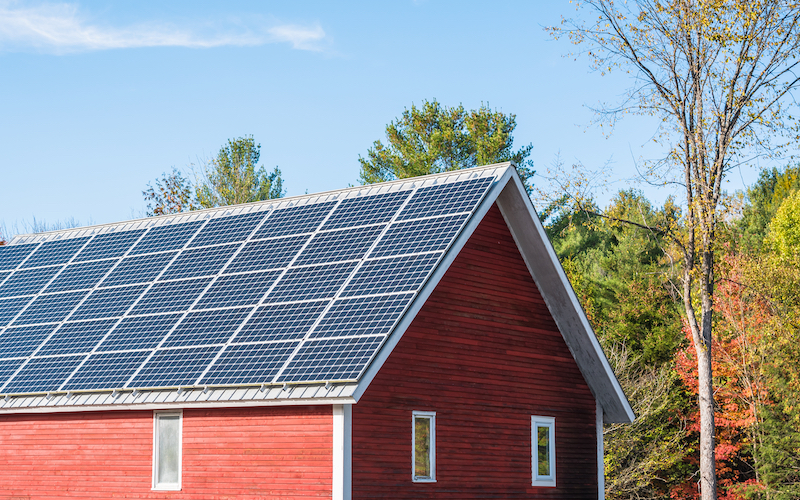
Vermont needs more clean energy to cut toxic pollution that fuels extreme weather. Photo: Shutterstock.
Things haven’t been easy for Vermont these past six months. Flood after flood has barraged our state, submerging our homes, disrupting our businesses, and inundating our roads with debris. And recent ice storms have downed trees, leaving Vermonters without electricity and sometimes trapped in our homes. But although these extreme storms have wreaked devastating losses, they’ve also reminded me of Vermonters’ collective power in working through challenges together. So many of us rolled up our sleeves, pulled on muck boots and gloves, strapped on masks, and got to work helping neighbors and businesses start to recover.
We know our mighty state is ready to rise to a challenge for the sake of our loved ones, homes, treasured local businesses, and way of life. Now, it’s time to come together around sensible policy reforms to slow climate change and its devastating impacts. Updating Vermont’s outdated Renewable Energy Standard is one vital policy reform that can help us tackle the climate crisis.
What is Vermont’s Renewable Energy Standard?
The Renewable Energy Standard requires Vermont utility companies to acquire a percentage of the electricity they sell from clean energy sources, like wind, solar, and hydropower. Currently, the standard requires companies to gradually increase the amount of clean electricity they sell until it reaches three-quarters of the power supply by 2032. Out of that amount, 10% must come from in-state clean energy sources.
Vermont passed the original standard nearly a decade ago, in 2015. So much has happened in the worlds of clean energy and climate change since then, including the passage of the state’s climate law. That climate law requires the government to significantly cut climate-warming pollution over time, with the first deadline coming in 2025. Clean energy has also become far more affordable and often less expensive than fossil fuel-generated electricity.
We know now more than ever that climate change is here and only getting worse. Paired with the fact that Vermont likely isn’t on track to meet its 2025 climate pollution reduction target, the state needs to step up with concrete action to get on track. Updating a decade-old policy is a key step in doing that.
Here’s why CLF Supports Reforming the Renewable Energy Standard
Legislators recently introduced a Renewable Energy Standard update bill, thanks in part to the positive efforts of a legislative working group that met this past summer and fall (on which CLF served alongside environmental groups, electric utilities, and other stakeholders). The bill brings Vermont’s Renewable Energy Standard in line with other New England states by requiring more new, clean, cost-saving renewable resources to come online soon. Here are a few reasons why CLF supports H.289:
- The bill boosts the 75% renewable energy requirement to 100% for almost all Vermonters by 2030.
- It moves the amount of in-state renewable energy utilities must provide from 10% to 20% (with the implementation year varying by utility).
- It requires utilities to purchase new in-region renewables, like offshore wind (with the quantity and compliance year varying by utility). It’s important that Vermont utilities are well-positioned to help support and take advantage of the development of a responsible offshore wind market.
- The bill eliminates new biomass-generated electricity, which is not only climate-damaging due to climate pollution associated with burning wood, but also bad for our health due to the air pollutants that stream out of biomass smokestacks.
- Environmental groups defeated calls which would have made the bill put nuclear power on par with wind, solar, and hydro power and establish a structure that would further increase Vermont’s reliance on non-renewable nuclear power.
The emphasis on new renewable energy is important because fighting climate change means electrifying many aspects of our lives — from the cars we drive to how we heat our homes and businesses. Naturally, this surge of electrification will increase the overall electricity demand — and these new energy sources can match the need without having to turn to fossil fuels or backup electricity from dirty power plants. More clean energy also means less air pollution, yet another toxic byproduct of burning fossil fuels, especially for the communities that house power plants in the state and throughout the region.
What Comes Next?
The bill is being heard in the House right now. We need your voices to help legislators understand that Vermonters deserve an updated Renewable Energy Standard and that this bill is the way to do it. Please consider contacting your legislative representative now to indicate your support for H.289. You can also sign up for CLF’s e-news so you’ll be the first to know how the bill advances in the General Assembly and when you could help move this across the finish line to become law.
As we work to increase the amount of renewable energy, we must also ensure that affordable housing developers and low-income Vermonters can access solar power’s cost-saving and health benefits regardless of socioeconomic status. Efforts are underway to address this issue, partly through language in this bill. But we need to do more, and we’ll call on you to support future legislation dealing with this important equity challenge.
I do not doubt Vermont’s determination to dig each other out of catastrophe. For the past six months, I’ve seen that determination in action every single day. Together, we can accomplish anything — which is why we need all hands on deck in the same way when creating policies to fight climate change. I’ll be counting on your support to move this critical update to our Renewable Energy Standard forward.




